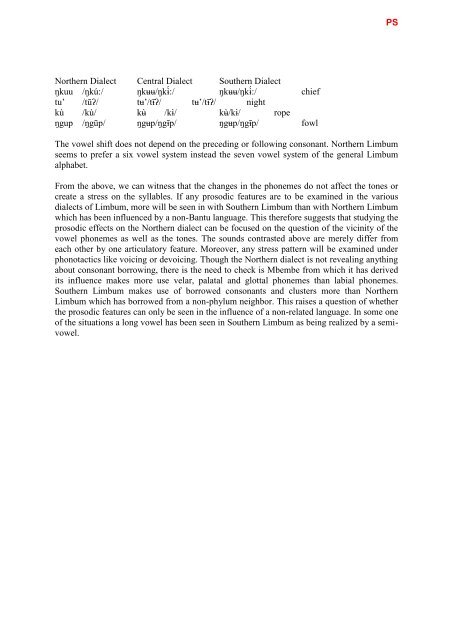here - 5th International Conference on Bantu Languages
here - 5th International Conference on Bantu Languages
here - 5th International Conference on Bantu Languages
You also want an ePaper? Increase the reach of your titles
YUMPU automatically turns print PDFs into web optimized ePapers that Google loves.
Northern Dialect Central Dialect Southern Dialect<br />
ŋkuu<br />
tuʼ<br />
/ŋkú:/<br />
/tūʔ/<br />
ŋkʉʉ/ŋkɨ̀ ́:/<br />
tʉʼ/tɨ̄ʔ/<br />
ŋkʉʉ/ŋkɨ̀ ́:/<br />
tʉʼ/tɨ̄ʔ/ night<br />
chief<br />
kù<br />
ŋgup<br />
/kù/<br />
/ŋgū p/<br />
kʉ̀ /kɨ̀/<br />
ŋgʉp/ŋgɨ̄p/<br />
kʉ̀/kɨ̀/<br />
ŋgʉp/ŋgɨ̄p/<br />
rope<br />
fowl<br />
The vowel shift does not depend <strong>on</strong> the preceding or following c<strong>on</strong>s<strong>on</strong>ant. Northern Limbum<br />
seems to prefer a six vowel system instead the seven vowel system of the general Limbum<br />
alphabet.<br />
From the above, we can witness that the changes in the ph<strong>on</strong>emes do not affect the t<strong>on</strong>es or<br />
create a stress <strong>on</strong> the syllables. If any prosodic features are to be examined in the various<br />
dialects of Limbum, more will be seen in with Southern Limbum than with Northern Limbum<br />
which has been influenced by a n<strong>on</strong>-<strong>Bantu</strong> language. This t<str<strong>on</strong>g>here</str<strong>on</strong>g>fore suggests that studying the<br />
prosodic effects <strong>on</strong> the Northern dialect can be focused <strong>on</strong> the questi<strong>on</strong> of the vicinity of the<br />
vowel ph<strong>on</strong>emes as well as the t<strong>on</strong>es. The sounds c<strong>on</strong>trasted above are merely differ from<br />
each other by <strong>on</strong>e articulatory feature. Moreover, any stress pattern will be examined under<br />
ph<strong>on</strong>otactics like voicing or devoicing. Though the Northern dialect is not revealing anything<br />
about c<strong>on</strong>s<strong>on</strong>ant borrowing, t<str<strong>on</strong>g>here</str<strong>on</strong>g> is the need to check is Mbembe from which it has derived<br />
its influence makes more use velar, palatal and glottal ph<strong>on</strong>emes than labial ph<strong>on</strong>emes.<br />
Southern Limbum makes use of borrowed c<strong>on</strong>s<strong>on</strong>ants and clusters more than Northern<br />
Limbum which has borrowed from a n<strong>on</strong>-phylum neighbor. This raises a questi<strong>on</strong> of whether<br />
the prosodic features can <strong>on</strong>ly be seen in the influence of a n<strong>on</strong>-related language. In some <strong>on</strong>e<br />
of the situati<strong>on</strong>s a l<strong>on</strong>g vowel has been seen in Southern Limbum as being realized by a semivowel.<br />
PS


